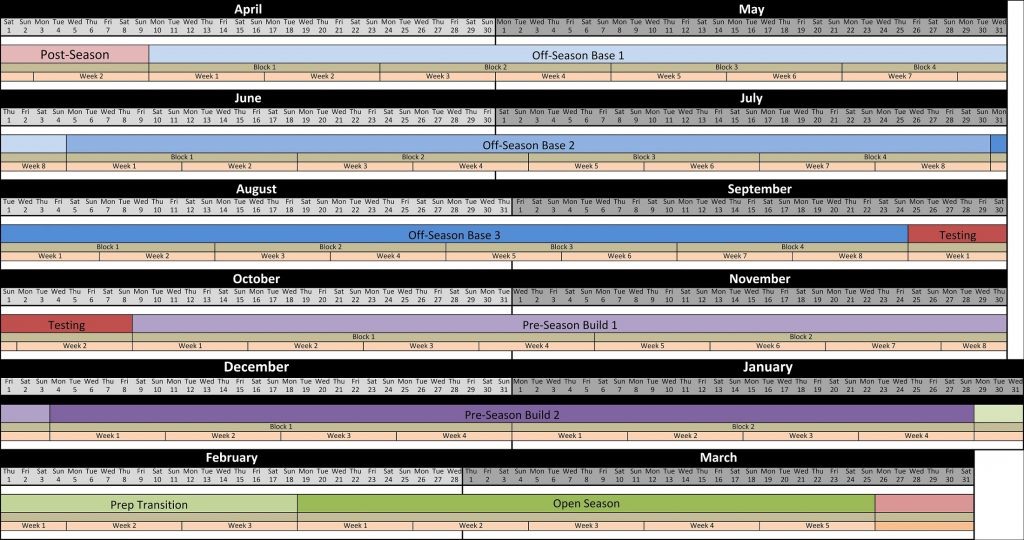This Training Cycle: A primer on periodization and what to expect
At Ironstone one of the things we have attempted to do is explain to our members on a deeper level why they are doing the things they are and what the intent is of each piece. To open that conversation for this off-season we are going to take a few minutes today to explain what to expect over the coming 24 weeks, why you will feel a shift in the programming and how we will accomplish our off-season goals (the ones we, the staff, have set for you, the members).
What is Periodization?
In classic Strength & Conditioning periodization is the systematic planning of athletic progress with the intent of “peaking” an athlete for the most important events in their competition season. Classic periodization models use an off-season, pre-season, in-season, and transition periods as a basic structure. Periodization is extremely effective at creating specific adaptations in athletes who compete in a sport. The CrossFit methodology, on the other hand, uses primarily CV-HI-FM (Constantly Varied, High Intensity, Functional Movements) to impact long term overall fitness. CV-HI-FM is extremely effective at improving broadly defined fitness for the general population, but the path to specific improvements in defined areas (strength, gymnastics, etc) is much slower using a pure CV-HI-FM model. Our experience has been that using a hybrid approach to training creates the desired progress for our members in the areas they appreciate while maintaining the overall spirit of CrossFit. The approach is still CV-HI-FM, we simply use a periodized framework to plan our training focus and place some constraints on the variance that follows during a given period.
Incorporating periodization allows us to focus on specific goals as a gym during a given window of time before advancing or building on those accomplishments and moving on to a new set of goals. The Open, our 5 week test of fitness and mental fortitude, can create a mental and physical overload and leave our athletes (all of you are athletes) with a feeling of exhaustion in the weeks that follow; this logically requires some decompression. With the unpredictability of each workout announcement for the duration of the Open and the training chaos that ensues its nice to have a mental break to focus on specific weaknesses (often identified during the course of the Open) and to develop a predictable routine. This creates a natural season for the gym whereby the Open is our peaked phase and the period that follows becomes the transition to our off-season.
Macro-Cycle Overview
The Off-Season is where we have arrived. The picture below gives you an overview of the 365 days that will make up this training year. We are currently in the 2nd Block of Off-Season 1. Each Off-Season meso-cycle is 8 weeks long culminating in a testing phase at the end of the third block.

The Off-Season meso-sycles are when you will most “feel” the periodization in our schedule. They have a predictable rhythm and tempo with each block arranged around a 2 week template. As we advance to the pre-season the focus will shift from specific adaptations to general; resulting in a less predictable rhythm as we return to partial and ultimately full-integration of the many skills we have been working on independent of our conditioning pieces. For the curious minded, the class template is below. There is nothing secret about it; after a few weeks you would be able to easily reconstruct it from the workouts we’ve done and the pattern we follow.

Our Focus this Meso-Cycle
You’ll note 5 areas of focus on the left and days of the week on the top. Some prescriptions are very specific (e.g. back squat) others are far more general (e.g. upper/lower gymnastic work). The conditioning pieces are not represented in this graphic. This categorized approach to focusing each day allows the prioritization of specific adaptations through increased frequency and structure. The resulting priorities that have been set for the gym are:
- Raw overhead pressing, pulling, and squatting strength
- Weightlifting Technique in the clean and snatch.
- Gymnastic Technique and Efficiency
- Improvement of supporting Structures
- cardio-respiratory endurance with a focus on Mental and physical stamina and durability.
Each item will have a decidedly different method. For instance, Strength training we will use linear progressions (level 1) and 5/3/1 (level 2) throughout the duration of off-season 1, 2 and 3, while for olympic lifting we will be doing primarily positional work in off-season 1, time under tension work in off-season 2, and percentage waves off-season 3.
What about Variance?
I think you’ll find the answer to that question moot given a few weeks. Yes, the main lifts may be templated on some days but the loading, intensity, and structure will vary quite widely. The conditioning pieces will always be CV-HI-FM, and on days were we schedule accessory or gymnastics work the METCON will remain the main course while the other elements are merely appetizer or dessert. This is true CrossFit in its purest form, the difference being that we have “prescribed” to your coaches what to do with the remaining class time available.
I’m just here for Fitness, why am I training like an Athlete?
Simply put, progress is powerful. Off-Season templating allows us to reward your commitment and routine with the progress demands we hear most often: strength, technique, and aerobic capacity. The dose is managed, and if you follow the class structure its only 1 hour, as always. The framework we use shouldn’t be what worries you in the long run, as long as you are getting the results. Sometimes that means doing the fun things (i.e. Deadlifts) and sometimes that means working hard at our weaknesses and things we don’t like (e.g. 8 x 400 M row anyone….)
Besides, its not the template that gives us an excuse to program a 10 K run, that’s just how variance goes (kidding, we wouldn’t do that).
(or would we?)
